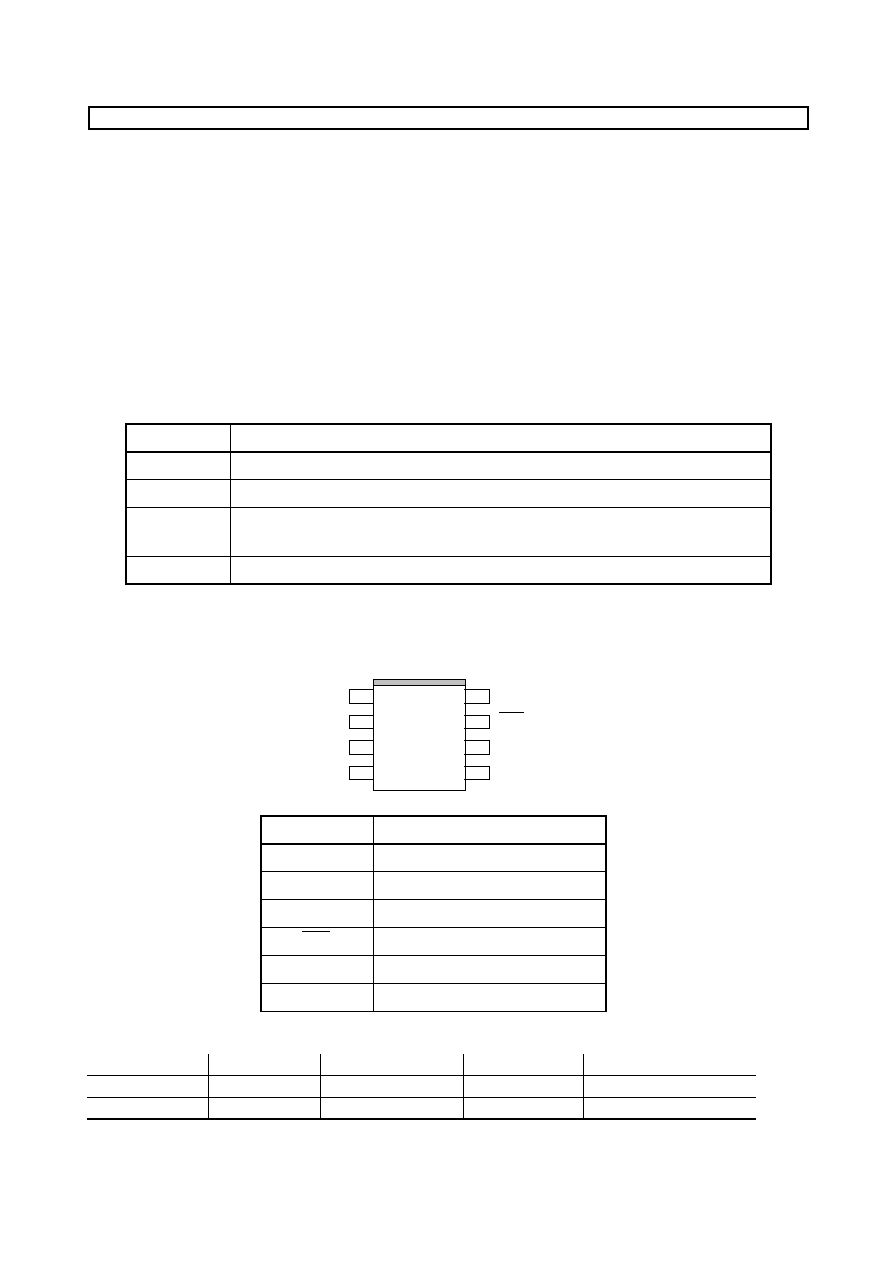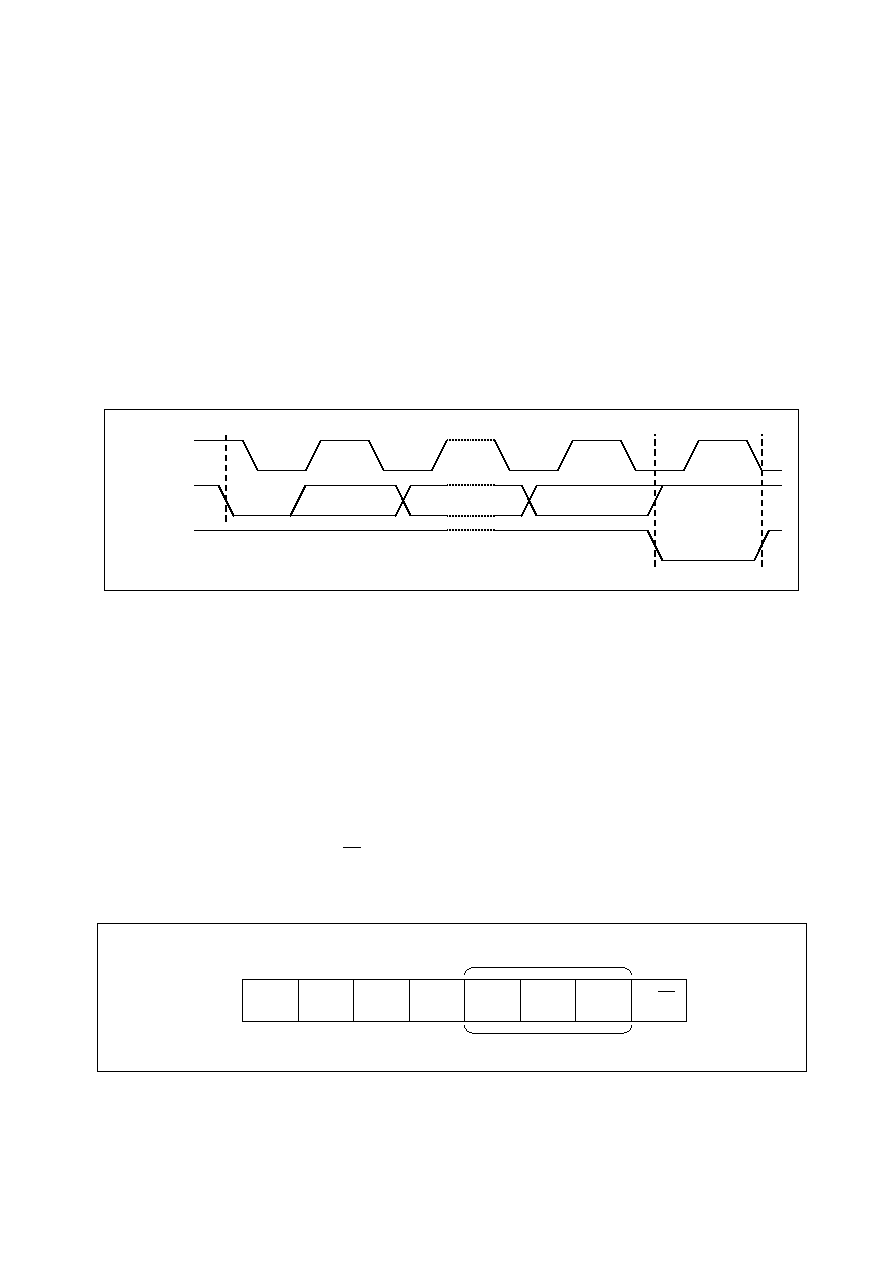 | –≠–ª–µ–∫—Ç—Ä–æ–Ω–Ω—ã–π –∫–æ–º–ø–æ–Ω–µ–Ω—Ç: AK6012A | –°–∫–∞—á–∞—Ç—å:  PDF PDF  ZIP ZIP |

ASAHI KASEI
[AK6010A/12A]
DAI02E-03
2002/11
- 1 -
AK6010A / 12A
I
2
C bus 32K / 64Kbit Serial CMOS EEPROM
Features
ADVANCED CMOS EEPROM TECHNOLOGY
READ/WRITE NON-VOLATILE MEMORY
WIDE VCC OPERATION : VCC = 1.8V to 5.5V
AK6010A 32768 bits, 4096 x 8 organization
AK6012A
65536 bits, 8192 x 8 organization
I
2
C
TM
SERIAL INTERFACE
LOW POWER CONSUMPTION
- 0.8µA Max. Standby
HIGH RELIABILITY
- Endurance
: 100K cycles
- Data Retention : 10 years
32 byte Page Write Mode
Automatic write cycle time-out with auto-ERASE
IDEAL FOR LOW DENSITY DATA STORAGE
- Low cost, space saving, 8-pin package (SOP)
Block Diagram
I
2
C
TM
is a registered trademark of Philips Corporation.
SLAVE ADDRESS
REGISTER
+COMPARATOR
START
STOP
LOGIC
VCC
GND
WC
SDA
SCL
S2
S1
CONTROL
LOGIC
WORD
ADDRESS
COUNTER
XDEC
AK6010A = 32768bit
AK6012A = 65536bit
EEPROM
H.V.GENERATION
TIMING
& CONTROL
YDEC
DATA REGISTER
DOUT
ACK
S0

ASAHI KASEI
[AK6010A/12A]
DAI02E-03
2002/11
- 2 -
General Description
The AK6010A/12A is a 32768/65536-bit serial CMOS EEPROM divided into 4096/8192 registers of
8 bits each.
The AK6010A/12A can operate full function under wide operating voltage range from 1.8V to 5.5V.
The charge up circuit is integrated for high voltage generation that is used for write operation.
The AK6010A/12A conforms to all specifications in the 2 wire protocol and is controlled by serial
clock (SCL) and serial data (SDA) line.
Some devices can be connected to the same bus. Each device connected to the bus is software
addressable by a unique address, and can operate as either a transmitter or receiver. In addition
to transmitters and receivers, devices can also be considered as masters or slaves when performing
data transfers (see Table1). The master is the device which initiates a data transfers on the bus
and generates the clock signals to permit that transfer. At that time, the device addressed is
considered as the slave.
TERM DESCRIPTION
Transmitter The device which sends the data to the bus
Receiver
The device which receives the data from the bus
Master
The device which initiates a transfer, generates clock signals and
terminates a transfer
Slave
The device addressed by a master
Table 1. Definitions
Pin arrangement
Pin Name
Function
S0, S1, S2
Device Address Inputs
SCL Clock
Input
SDA
Data Input / Output
WC Write
Control
VCC Power
Supply
GND Ground
Type of Products
Model
Memory size
Temp. Range
VCC
Package
AK6010AF
32K bits
-40∞C to +70∞C
1.8V to 5.5V
8pin Plastic SOP
AK6012AF
64K bits
-40∞C to +70∞C
1.8V to 5.5V
8pin Plastic SOP
AK6010A/12A
GND
S2
S0
S1
2
1
3
4
VCC
7
8
6
5 SDA
SCL
WC

ASAHI KASEI
[AK6010A/12A]
DAI02E-03
2002/11
- 3 -
DATA TRANSFER
All commands are preceded by a START condition. After the START condition, a slave address is
sent. After the AK6010A/12A recognizes the START condition, the devices interfaced to the bus
wait for the slave address to be transmitted over the SDA line. If the transmitted slave address
matches an address of one of the devices, the designated slave pulls the SDA line to LOW
(ACKNOWLEDGE).
The data transfer is always terminated by a STOP condition generated by the master.
[Data validity]
The data on the SDA line must be stable during the HIGH period of the clock. The HIGH or LOW
state of the data line can only change when the clock signal on the SCL line is LOW.
Figure 1. Data transfer
[START and STOP condition]
A HIGH to LOW transition on the SDA line while SCL is HIGH defines a START condition. All
commands are preceded by the START condition.
A LOW to HIGH transition on the SDA line while SCL is HIGH defines a STOP condition. All
communications are terminated by the STOP condition. After a read sequence, the STOP
condition will place the EEPROM in a standby power mode.
Figure 2. Start and Stop Definition
DATA STABLE
DATA
CHANGE
SDA
SCL
START CONDITION
SDA
SCL
STOP CONDITION

ASAHI KASEI
[AK6010A/12A]
DAI02E-03
2002/11
- 4 -
[ACKNOWLEDGE]
ACKNOWLEDGE is a software convention used to indicate successful data transfers. The
transmitting device will release the bus after transmitting eight bits. During the next clock (ninth
clock), the receiver will pull the SDA line to LOW to acknowledge that it received the eight bits of
data.
The AK6010A/12A will respond with an acknowledge after recognition of a start condition and its
slave address. If both the device and a write operation have been selected, the AK6010A/12A will
respond with an acknowledge after the receipt of each subsequent eight bit word.
In the read mode the AK6010A/12A slave will transmit eight bits of data, release the SDA line and
monitor the line for an acknowledge. If an acknowledge is detected and no STOP condition is
generated by the master, the slave will continue to transmit data. If an acknowledge is not
detected, the slave will terminate further data transmissions and await the STOP condition to return
to the standby power mode.
Figure 3. Acknowledge Response from Receiver
[SLAVE ADDRESS]
After the START condition, a SLAVE ADDRESS is sent. If the transmitted slave address matches
an address of one of the device, the designated slave pulls the SDA line to LOW.
The most significant four bits of the slave address are fixed as "1010". The next three bits are S0,
S1 and S2 device address bits. These three bits identify the specific device on the bus. They is
set by the hard wired input pins (S0 pin, S1 pin and S2 pin). Therefore a total of eight devices can
be connected to the same bus.
The last bit of the slave address (R/W bit) defines whether a write or read condition is requested by
the master. A "1" indicates that the read operation is to be executed. A "0" indicates that the write
operation is to be executed.
Figure 4. Slave Address
1
They is set by the hard-wired input pins (S0 pin, S1 pin and S2 pin).
DEVICE ADDRESS
0 1 0 S2
S1
S0
R/W
DATA
OUTPUT
FROM
TRANSMITTER
ACKNOWLEDGE
DATA
OUTPUT
FROM
RECEIVER
SCL FROM
MASTER
1
8
9

ASAHI KASEI
[AK6010A/12A]
DAI02E-03
2002/11
- 5 -
Pin Descriptions
SCL
(Serial Clock)
The SCL input is used to clock all data into and out of the device.
SDA
(Serial Data)
The SDA is a bidirectional pin used to transfer data into and out of the device.
It is an open drain output and may be wire-ORed with any number of open drain or open
collector outputs.
S0, S1, S2
(Device Address)
The S0, S1 and S2 are device address inputs that are used to set three bits of the slave
address.
A total of eight devices can be connected to the same bus.
WC
(Write Control)
If the WC is High level, WRITE operations onto the upper quarter of the memory (AK6010A:
C00 to FFF(Hex), AK6012A: 1800 to 1FFF(Hex)) will not be executed. If the WC is Low level,
the AK6010A/12A will be enabled to perform WRITE operation.
As the WC is internally pulled down to GND, the AK6010A/12A will be enabled to perform
WRITE operation if the WC is left floating.
WC must not change from the start condition input to the stop condition input.
VCC
(Power Supply)
GND
(Ground)




